D-Link DWL-2000AP User Manual

D-Link AirPlus Xtreme G™
DWL-2000AP
High-Speed 2.4 GHz Wireless Access Point
Manual
Building Networks for People
Contents
Package Contents ................................................................................ |
3 |
Introduction........................................................................................... |
4 |
Wireless Basics.................................................................................... |
8 |
Getting Started ................................................................................... |
12 |
Using the Configuration Menu............................................................ |
14 |
Networking Basics.............................................................................. |
25 |
Troubleshooting .................................................................................. |
40 |
Technical Specifications ..................................................................... |
47 |
Contacting Technical Support............................................................. |
50 |
Warranty and Registration.................................................................. |
51 |
2
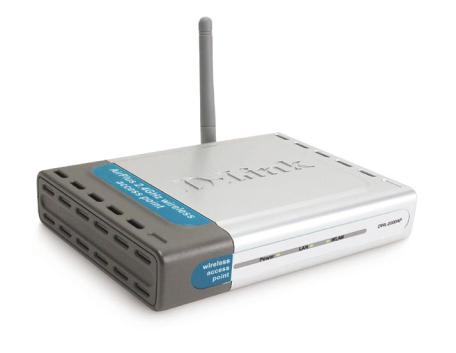
Package Contents
D-Link AirPlus Xtreme G™ DWL-2000AP
High-Speed 2.4GHz Wireless Access Point
Power Adapter-DC 5V, 2.0A Manual and Warranty on CD Quick Installation Guide Ethernet Cable
If any of the above items are missing, please contact your reseller.
Note: Using a power supply with a different voltage rating than the one included with the DWL-2000AP will cause damage and void the warranty for this product.
System Requirements for Configuration:
Computers with Windows, Macintosh, or Linux-based operating systems with an installed Ethernet adapter
Internet Explorer Version 6.0 or Netscape Navigator Version 6.0 and Above
3
Introduction
The D-Link AirPlus Xtreme G™ DWL-2000AP High-Speed Wireless Access Point is a draft 802.11g high-performance, wireless access point that supports high-speed wireless networking at home, at work or in public places.
The DWL-2000AP is capable of operating in one of 4 different modes to meet your wireless networking needs. The DWL-2000AP can operate as an Access Point; in Access Point-to-Access Point Bridging mode;Access Point-to-Multipoint Bridging mode; or Wireless Client mode.
The DWL-2000AP is an ideal solution for quickly creating and extending a wireless local area network (WLAN) in offices or other workplaces, trade shows and special events.
Unlike most access points, the DWL-2000AP provides data transfers at up to 54 Mbps* (compared to the standard 11 Mbps) when used with other D-Link AirPlus Xtreme G™ products.The 802.11g standard is backwards compatible with 802.11b products.This means that you do not need to change your entire network to maintain connectivity.You may sacrifice some of 802.11g’s speed when you mix 802.11b and 802.11g devices, but you will not lose the ability to communicate when you incorporate the 802.11g standard into your 802.11b network.You may choose to slowly change your network by gradually replacing the 802.11b devices with 802.11g devices .
In addition to offering faster data transfer speeds when used with other 802.11g products, the DWL-2000AP has the newest, strongest, most advanced security features available today.When used with other 802.11g WPA (WiFi Protected Access) and 802.1x compatible products in a network with a RADIUS SERVER, the security features include:
WPA:* |
A new security feature, Wi-Fi Protected Access authorizes and identifies |
|
users based on a secret key that changes automatically at a regular |
|
interval. WPA uses TKIP (Temporal Key Integrity Protocol) to change the |
|
temporal key every 10,000 packets (a packet is a kind of message |
|
transmitted over a network.) This insures much greater security than the |
|
standard WEP security. (By contrast, the older WEP encryption required |
|
the keys to be changed manually.) |
802.1x*: |
Authenticationisafirstlineofdefenseagainstintrusion.Inthe Authentication |
|
process the server verifies the identity of the client attempting to connect |
|
to the network.Unfamiliar clients would be denied access. |
* Available Spring 2003 as a free download
*Maximum wireless signal rate based on IEEE Standard 802.11g specifications. Actual data throughput will vary. Network conditions and environmental factors, including volume of network traffic, building materials and construction and network overhead lower actual data throughput rate.
4
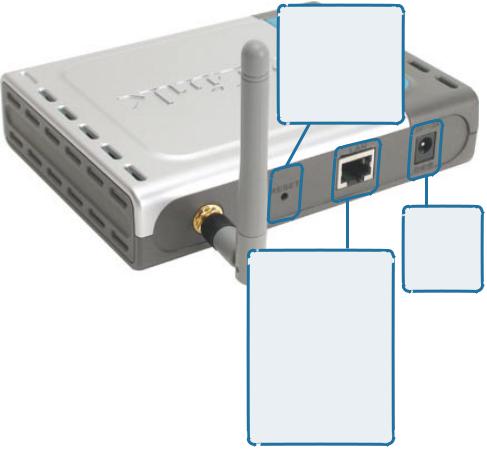
Connections
Pressing the
Reset Button restores the router to its original factory default settings.
The LAN Port is Auto-MDI/MDIX. You can insert either a Straight-through or a Cross-over Ethernet cable in this port in order
to connect the DWL-2000AP to a switch on the local network.
Receptor for the
Power
Adapter
5
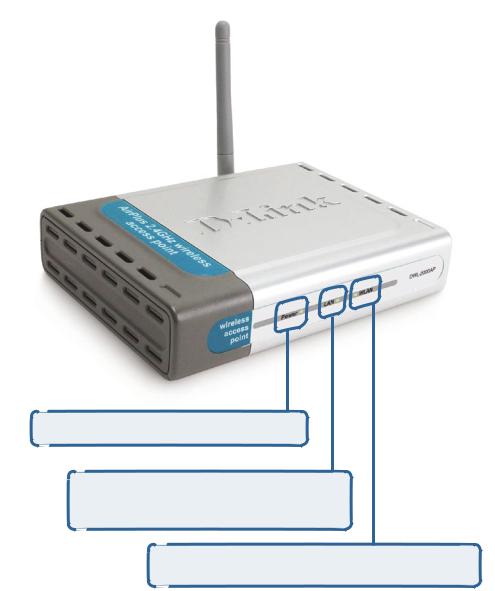
LEDs
LED stands for Light-Emitting Diode. The DWL-2000AP Wireless Access Point has 3 LEDs as shown below:
Power: Solid green light indicates connection
LAN: Blinking green light indicates activity on the Ethernet Port;solid green light indicates connection
WLAN: Blinking green light indicates wireless activity; solid green light indicates connection
6
Features
4 Different Operation modes - Capable of operating in one of four different operation modes to meet your wireless networking requirements: Access Point; AP-to-AP Bridging; AP-to-Multipoint Bridging; and Wireless Client.
Faster wireless networking with the draft 802.11g standard to provide a wireless data rate of up to 54Mbps*
Compatible with the 802.11b standard to provide a wireless data rate of up to 11Mbps - that means you can migrate your system to the 802.11g standard on your own schedule without sacrificing connectivity.
Better security with WPA* and 802.1x*
WPA* (Wi Fi Protected Access) authorizes and identifies users based on a secret key that changes automatically at a regular interval
TKIP (Temporal Key Integrity Protocol), in conjunction with a RADIUS SERVER, changes the temporal key every 10,000 packets, ensuring greater security
Pre Shared Key mode means that the home user, without a RADIUS SERVER, will obtain a new security key every time he or she connects to the network, vastly improving the safety of communications on the network.
802.1x* Authentication in conjunction with the RADIUS SERVER verifies the identity of would be clients
Utilizes OFDM technology (Orthogonal Frequency Division Multiplexing)
Operates in the 2.4GHz frequency range
Easy Installation with the Setup Wizard
Web-based interface for Managing and Configuring
*Maximum wireless signal rate based on IEEE Standard 802.11g specifications. Actual data throughput will vary. Network conditions and environmental factors, including volume of network traffic, building materials and construction and network overhead lower actual data throughput rate.
* Available Spring 2003 as a free download |
7 |
|
Wireless Basics
D-Link wireless products are based on industry standards to provide easy-to-use and compatible high-speed wireless connectivity within your home, business or wherever a wireless network is available.D-Link wireless products will allow you access to the data you want, when and where you want it.You will be able to enjoy the freedom that wireless networking brings.
A wireless local area network (WLAN) is a cellular computer network that transmits and receives data with radio signals instead of wires. WLANs are used increasingly in both home and office environments, and public areas such as airports, coffee shops and universities. Innovative ways to utilize WLAN technology are helping people to work and communicate more efficiently. Increased mobility and the absence of cabling and other fixed infrastructure
have proven to be beneficial for many users.
Wireless users can use the same applications they use on a wired network. Wireless adapter cards used on laptop and desktop systems support the same protocols as Ethernet adapter cards.
Under many circumstances, it may be desirable for mobile network devices to link to a conventional Ethernet LAN in order to use servers, printers or an Internet connection supplied through the wired LAN. A Wireless Access Point is a device that can be used to provide this link.
8
Wireless Basics (continued)
People use WLAN technology for many different purposes:
Mobility - Productivity increases when people have access to data in any location within the operating range of the WLAN. Management decisions based on real-time information can significantly improve worker efficiency.
Low Implementation Costs – WLANs are easy to set up, manage, change and relocate. Networks that frequently change, both physically and logically, can benefit from a WLAN’s ease of implementation. WLANs can operate in
locations where installation of wiring may be impractical.
Installation and Network Expansion - Installing a WLAN system can be fast and easy and can eliminate the need to pull cable through walls and ceilings. Wireless technology allows the network to go where wires cannot go-even outside the home or office.
Scalability – WLANs can be configured in a variety of ways to meet the needs of specific applications and installations. Configurations are easily changed and range from peer-to-peer networks suitable for a small number of users to larger infrastructure networks to accommodate hundreds or
thousands of users, depending on the number of wireless devices deployed.
Inexpensive solution– Wireless network devices are as competitively priced as conventional Ethernet network devices.
The DWL-2000AP is compatible with the following wireless products:
D-Link AirPlus DWL-650+,D-Link AirPlus Xtreme G™ DWL-G650
Wireless Cardbus Adapters used with laptop computers
D-Link AirPlus DWL-520+, D-Link AirPlus Xtreme G™ DWL-G520
Wireless PCI cards used with desktop computers
9
Wireless Basics (continued)
Standards-Based Technology
The DWL-2000AP Wireless Access Point utilizes the new 802.11g1 standard.
The IEEE 802.11g standard is an extension of the 802.11b standard. It increases the data rate up to 54 Mbps within the 2.4GHz band, utilizing OFDM technology.
This means that in most environments, within the specified range of this device, you will be able to transfer large files quickly or even watch a movie in MPEG format over your network without noticeable delays. This technology works by transmitting high-speed digital data over a radio wave utilizing OFDM (Orthogonal Frequency Division Multiplexing) technology. OFDM works by splitting the radio signal into multiple smaller sub-signals that are then transmitted simultaneously at different frequencies to the receiver. OFDM reduces the amount of crosstalk (interference) in signal transmissions.The D-Link DWL-2000AP will automatically sense the best possible connection speed to ensure the greatest speed and range possible.
802.11g3 offers the most advanced network security features available today, including:WPA2 , 802.1x3, TKIP, AES and Pre-Shared Key mode. These security features are explained in more detail in the Introduction and the Features section of this manual.
The DWL-2000AP is backwards compatible with 802.11b devices. This means that if you have an existing 802.11b network, the devices in that network will be compatible with 802.11g devices at speeds of up to 11Mbps in the 2.4GHz range.
1 |
802.11g standard is scheduled for ratification by IEEE Summer 2003 |
|
2 |
WPA will be available Spring 2003 as a free download |
|
3 |
802.1x will be available Spring 2003 as a free download |
10 |
|
|
Wireless Basics (continued)
Installation Considerations
The D-Link AirPlus Xtreme G™ DWL-2000AP lets you access your network, using a wireless connection, from virtually anywhere within its operating range. Keep in mind, however, that the number, thickness and location of walls, ceilings, or other objects that the wireless signals must pass through, may limit the range. Typical ranges vary depending on the types of materials and background RF (radio frequency) noise in your home or business.The key to maximizing wireless range is to follow these basic guidelines:
1.Keep the number of walls and ceilings between the DWL-2000AP and your receiving device (e.g., the DWL-G650 or the DWL-650+) to a minimum -each wall or ceiling can reduce your D-Link Wireless product’s range from 3-90 feet (1-30 meters.) Position your receiving devices so that the number of walls or ceilings is minimized.
2.Be aware of the direct line between routers and computers. A wall that is 1.5 feet thick (.5 meters), at a 45-degree angle appears to be almost 3 feet (1 meter) thick. At a 2-degree angle it looks over 42 feet (14 meters) thick! Position devices so that the signal will travel straight through a wall or ceiling (instead of at an angle) for better reception.
3.Building Materials can impede the wireless signal - a solid metal door or aluminum studs may have a negative effect on range.Try to position wireless devices and computers with wireless adapters so that the signal passes through drywall or open doorways and not other materials.
4.Keep your product away (at least 3-6 feet or 1-2 meters) from electrical devices or appliances that generate RF noise.
11
Getting Started
On the following pages we will show you an example of an Infrastructure Network incorporating the DWL-2000AP.
An Infrastructure network contains an Access Point or a Wireless Router. The Infrastructure Network example shown on the following page contains the following D-Link network devices (your existing network may be comprised of other devices):
A wireless Access Point -
D-Link AirPlus Xtreme G™ DWL-2000AP
A 4-port Ethernet Broadband Router - D-Link DI-604
A laptop computer with a wireless adapter -
D-Link AirPro DWL-G650
A desktop computer with a wireless adapter -
D-Link AirPlus Xtreme G™ DWL-G520, D-Link Air DWL-520, or D-Link AirPlus DWL-520+
(D-Link Air devices have speeds up to 11Mbps)
A Cable modem - D-Link DCM-200
12
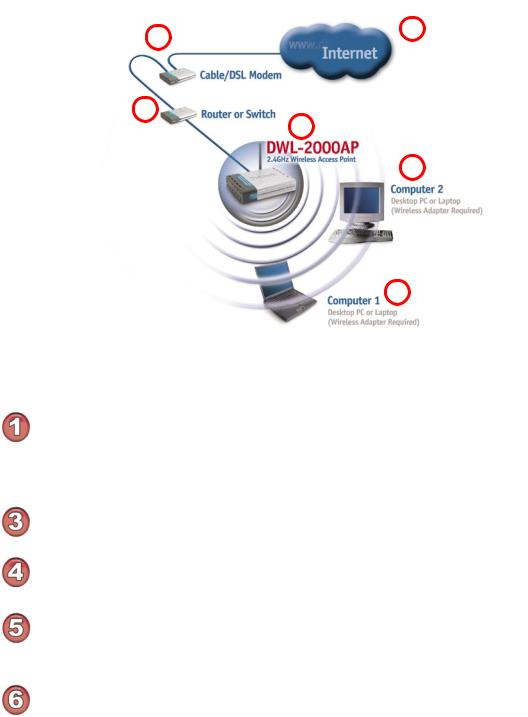
Getting Started (continued)
Setting up a Wireless
2 |
1 |
|
3
4
5
6
Please remember that D-Link Air Plus Xtreme G™ wireless devices are pre-configured to connect together, right out of the box, with their default settings.
For a typical wireless setup at home (as shown above), please do the following:
You will need broadband Internet access (a Cable or DSL-subscriber line into your home or office)
 Consult with your Cable or DSL provider for proper installation of the modem
Consult with your Cable or DSL provider for proper installation of the modem
Connect the Cable or DSL modem to the DI-604 Ethernet Broadband Router (see the printed Quick Installation Guide included with your router.)
Connect the Ethernet Broadband Router to the DWL-2000AP (See the printed Quick Installation Guide included with the DWL-2000AP.)
If you are connecting a desktop computer to your network, install the D-Link AirPlus Xtreme G™ DWL-G520 wireless PCI adapter into an available PCI slot on your desktop computer.You may also install the DWL-520+.
(See the printed Quick Installation Guide included with the network adapter.)
Install the drivers for the D-Link DWL-G650 wireless Cardbus adapter into a laptop computer.
(See the printed Quick Installation Guide included with the DWL-G650.) 13
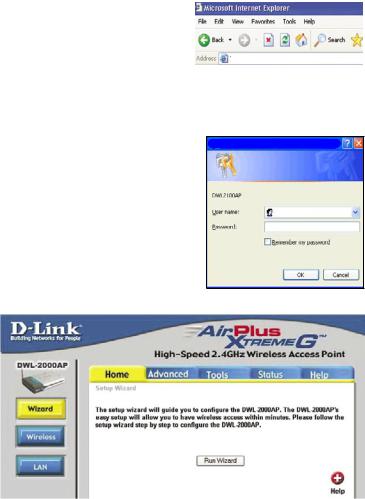
Using the Configuration Menu
After you have completed the SetupWizard (please see the Quick Installation Guide that came with the product) you can access the Configuration menu at any time by opening the web browser and typing in the IP Address of the DWL-2000AP.The DWL-2000AP default IP Address is shown below:
|
Open the web browser |
|
|
Type in the IP Address of the |
|
|
Router |
http://192.168.0.50 |
|
|
Note: if you have changed the default IP Address assigned to the DWL-2000AP, make sure to enter the correct IP Address.
Type admin in the User Name field
Leave the Password blank. (However, if you have changed the password, please enter the correct password.)
Click OK
Home > Wizard
Connect to 192.168.0.50
admin
The Home>Wizard screen will appear. Please refer to the QuickInstallationGuide for more information regarding the Setup Wizard.
14
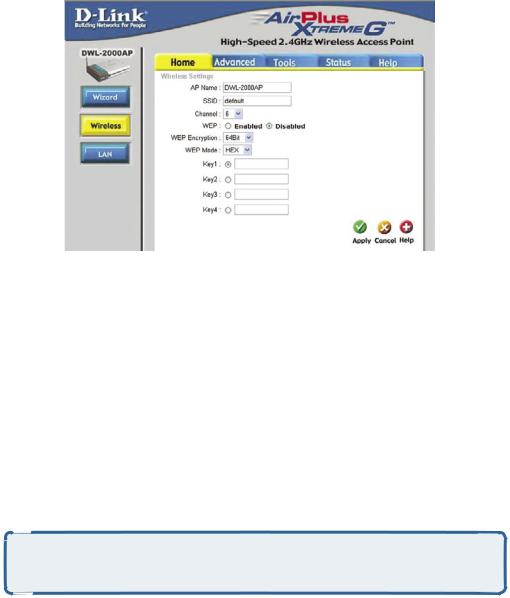
Using the Configuration Menu (continued)
Home > Wireless
SSID-
Channel-
Service Set Identifier (SSID) is the name designated for a specific
wireless local area network (WLAN).The SSID’s factory default setting is default. The SSID can be easily changed to connect to an existing
wireless network or to establish a new wireless network.
6 is the default channel. All devices on the network must share the same channel.
WEP- |
Wired Equivalent Privacy (WEP) is a wireless security protocol forWireless |
|
Local Area Networks (WLAN). WEP provides security by encrypting the |
|
data that is sent over the WLAN. Select Enabled or Disabled. Disabled is |
|
the default setting. (Note: If you enable encryption on the DWL-2000AP |
|
make sure to also enable encryption on all the wireless clients or wireless |
|
connection will not be established.) |
WEP |
|
Encryption- |
Select the level of encryption desired: 64-bit, or 128-bit |
Key Type- Select HEX or ASCII
Hexadecimal digits consist of the numbers 0-9 and the letters A-F
ASCII (American Standard Code for Information Interchange) is a code for representing English letters as numbers from 0-127
Keys 1-4- |
Input up to 4 WEP keys; select the one you wish to use. |
Apply- |
Click Apply to save the changes. |
15
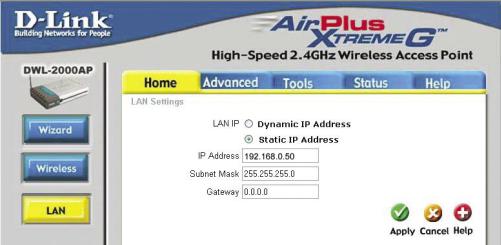
Using the Configuration Menu (continued)
Home > LAN
LAN is short for Local Area Network. This is considered your internal network. These are the IP settings of the LAN interface for the DWL-2000AP. These settings may be referred to as Private settings.You may change the LAN IP address if needed.The LAN IP address is private to your internal network and cannot be seen on the Internet.
IP Address-
Subnet Mask-
Gateway-
Apply-
The IP address of the LAN interface. The default IP address is: 192.168.0.50
The subnet mask of the LAN interface.
The default subnet mask is 255.255.255.0
This field is optional. Enter in the lP address of the router on your network.
Click Apply to save the changes.
16
